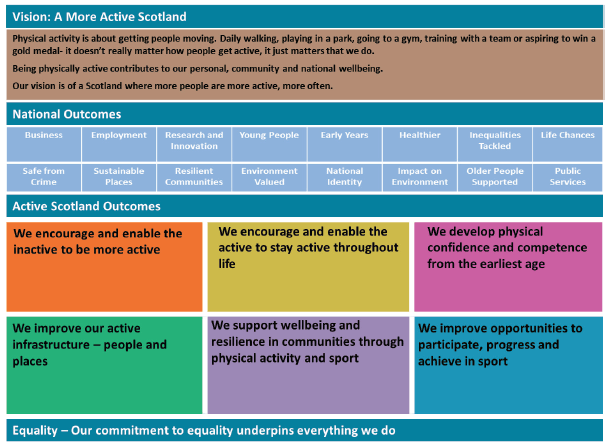Active Scotland Outcomes: Indicator Equality Analysis
This report presents an analysis of equality data across the indicators from the Active Scotland Outcomes Framework. Many data gaps were highlighted, however, available evidence points to inequality of opportunities and outcomes for all groups with protected characteristics across all the Active Scotland outcomes.
Introduction
1.1. This report presents a baseline review of statistics and research on equality issues across the Active Scotland Outcomes Framework. It encompasses the characteristics protected under legislation as well as socio-economic status, in recognition of the impact of broader inequalities in Scotland, particularly for those living in the most deprived areas.
1.2. This report is accompanied by an excel database detailing the available equality data breakdown for each protected characteristic and by outcome. This is available at:
http://www.gov.scot/Topics/ArtsCultureSport/Sport/Outcomes-Framework/Equality
1.3. The Active Scotland Outcomes Framework, developed collectively with partners through the National Strategic Group for Sport and Physical Activity (NSG) and published in 2014, describes Scotland's ambitions for sport and physical activity over the next ten years. It sets out a vision, six outcomes and a commitment to equality, see Figure 1.1. A suite of indicators is being used to measure and report on progress which includes measures of both opportunity and outcome, see Table 1.1.
Figure 1.1: Active Scotland Outcomes Framework

1.4. Pursuing the Active Scotland outcomes in a way that ensures equality of opportunity for all people in Scotland to be active and to fulfil their potential requires a strong evidence base to inform policy development and to form a baseline against which to evaluate progress.
Table 1.1: Active Scotland Outcomes and Indicators
| What the outcome is about | Indicators |
|---|---|
| A More Active Scotland | |
| This is the overall vision across the outcomes framework. Two overarching indicators monitor progress. The adult indicator is in the National Performance Framework. |
|
| We encourage and enable the inactive to be more active | |
| This outcome is about reducing inactivity in Scotland. There is no universal agreement about what constitutes low levels of activity for adults or children. Inactivity among adults is defined in this framework as less than 30 minutes moderate to vigourous physical activity per week. Globally, in 2013, the WHO developed a new voluntary target for member states to reduce physical inactivity by 10% by 2025. |
|
| We encourage and enable the active to stay active throughout life | |
| We know that the amount of physical activity we do varies greatly across the lifecourse. This outcome is about sustaining physical activity habits through key transitions in life and encouraging those who do some physical activity to do some more activity, more often. |
|
| We develop physical confidence and competence from the earliest age | |
| We want our children and young people to experience the joy of movement and develop positive attitudes to active living. This outcome is about ensuring all Scotland's children and young people develop the physical confidence and competence required for a foundation of lifelong participation in physical activity and sport |
|
| We improve our active infrastructure - people and places | |
| This outcome is about improving the infrastructure in Scotland that enables physical activity, i.e. the sports and exercise infrastructure and the built environment through, for example, better cycling and walking infrastructure. Critically, it is also about enhancing the people side of Scotland's active infrastructure, the parents, volunteers, teachers, coaches and leaders who play a vital role. |
|
| We support well-being and resilience in communities through physical activity and sport | |
| This outcome is about the development of communities through sport and physical activity, rather than developing sport in communities. Sport and physical activity is often seen as an end in itself, but can also be a means to develop wider social outcomes in communities, for example using sport to address education, employment and crime related issues. |
|
| We improve opportunities to participate, progress and achieve in sport |
|
| This outcome is about developing and supporting a world class sporting system at all levels, motivating more organisations and individuals to get involved and enabling the broadest range possible of people to participate, progress and achieve in sport. |
|
Contact
Email: Justine Geyer
There is a problem
Thanks for your feedback